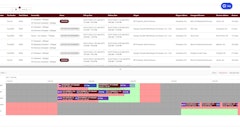
Reminiscent of the famed cheese caves in Europe, Wegmans Food Markets has opened its own caves in Rochester, N.Y.
On April 7, the store started fully operating its cheese caves, which are in a high-tech building that mimics the environments of the caves in Europe, said Cathy Gaffney, director of specialty cheeses, deli and kosher deli for Wegmans.
"Basically what we've done is, rather than those cheeses arriving in our stores and those cheeses having to go into temperatures at 41 degrees or below, (they'll be in a central location)," said Gaffney, who said the humidity, temperature and outside air flow are controlled in the caves. "(Previously) they would ripen a little bit, but they're all going to be at different stages. It's really difficult to teach people how to assess those cheeses and then bring them all to the (best) level of ripeness."
The 12,300-square-foot building houses a Brie room and seven caves where soft cheeses, such as Camembert, and washed-rind cheeses, such as bourbon-washed Pie d'Angloys, will be coaxed into a better flavor, Wegmans said in a news release.
As many as eight different types of cheese can be ripened within the facility at one time. Each cave is between 185- to 200-square-feet and houses one type of cheese at a time, so the flora from one type never mixes with those from other kinds, Wegmans said.
Gaffney said the central location in Rochester will make Wegmans' soft cheeses of better quality and more enjoyable for the customers.
"By having the central affinage, of the cave, we can actually perfect the quality of our cheeses there, so the (employees) don't need to try to do that in the stores," Gaffney said. "Our goal is to create high-quality products for our customers. The level of commitment and expense that we have put in place here, really just shows our customers that we want to provide them with the best quality cheeses."
Wegmans said ripening or aging cheese begins with inoculating milk with "friendly" bacteria and molds, which develop the cheese's distinctive flavor and texture. These desirable microorganisms can do this only within a specific range of temperatures and relative humidity. If the environment isn't kept in that range, cheese spoils or develops off-flavors -- which is why each cave's climate is controlled separately.
Because soft-ripened and washed-rind cheeses don't travel well, they are partially ripened for a few weeks or months in the country of origin and then chilled to delay further development during shipping. When the under-ripe cheeses arrive in the United States, they need additional care for a few days or weeks under ideal conditions for their full flavor to develop.
Gaffney said the facility will allow some of Wegmans own cheeses to reach their ripest and best flavor. Those varieties need to be ripened at a temperature higher than at which they usually are stored in the cheese cases at the store.
"The best and easiest way to think about (the flavor is by thinking about fruit)," Gaffney said. "Take bananas for instance. If you eat a green banana versus a yellow banana versus a really brown banana, that product really changes not only in flavor but (also) in texture. So the same thing happens with cheese. Those cheeses, if they're not at their perfect level of ripeness, you're either going to be very unhappy because it doesn't have a lot of flavor and you're going to wonder why everybody makes a big fuss about why they taste so good, or it's going to be ammoniated and over-ripe and really not taste good at all."



























